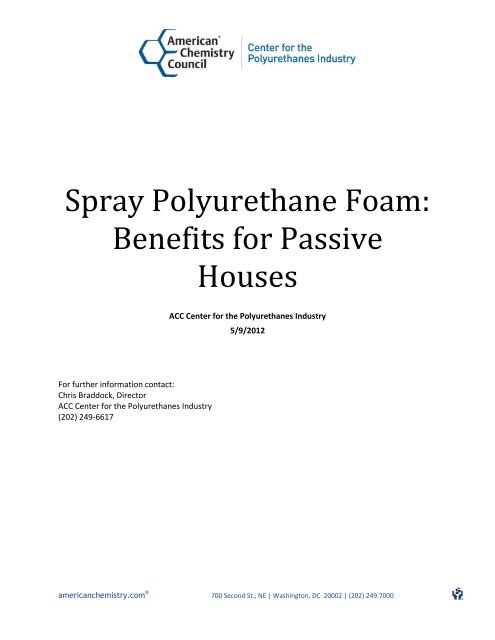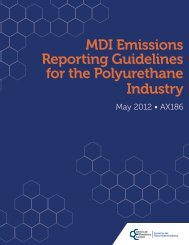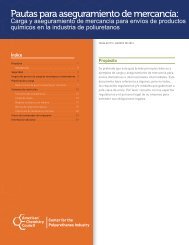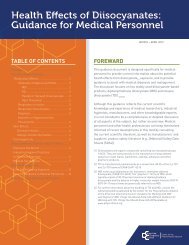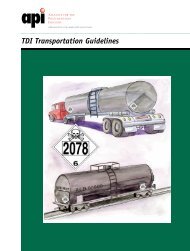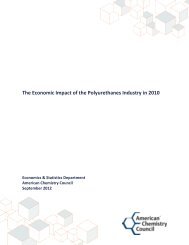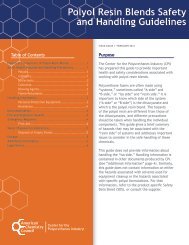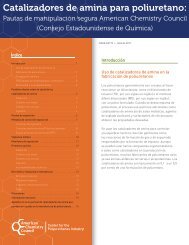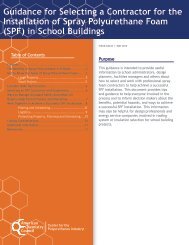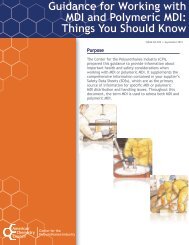Spray Polyurethane Foam: Benefits for Passive Houses
Spray Polyurethane Foam: Benefits for Passive Houses
Spray Polyurethane Foam: Benefits for Passive Houses
Create successful ePaper yourself
Turn your PDF publications into a flip-book with our unique Google optimized e-Paper software.
<strong>Spray</strong> <strong>Polyurethane</strong> <strong>Foam</strong>:<br />
<strong>Benefits</strong> <strong>for</strong> <strong>Passive</strong><br />
For further in<strong>for</strong>mation contact:<br />
Chris Braddock, Director<br />
ACC Center <strong>for</strong> the <strong>Polyurethane</strong>s Industry<br />
(202) 249-6617<br />
<strong>Houses</strong><br />
ACC Center <strong>for</strong> the <strong>Polyurethane</strong>s Industry<br />
5/9/2012<br />
americanchemistry.com ® 700 Second St., NE | Washington, DC 20002 | (202) 249.7000
<strong>Spray</strong> <strong>Polyurethane</strong> <strong>Foam</strong>: <strong>Benefits</strong> <strong>for</strong> <strong>Passive</strong> <strong>Houses</strong><br />
The Center <strong>for</strong> the <strong>Polyurethane</strong>s Industry 1 and the <strong>Spray</strong> <strong>Foam</strong> Coalition, 2 which are part of the<br />
American Chemistry Council (ACC), represent U.S. producers or distributors of chemicals and equipment<br />
used to make polyurethane or manufacturers of polyurethane products. <strong>Passive</strong> House Institute US<br />
(PHIUS) has provided ACC an opportunity to publish a document in the PHIUS newsletter alongside a<br />
document by the PHIUS Technical Committee on spray polyurethane foam (SPF). We appreciate the<br />
opportunity extended to us to discuss and to clarify some reasons why SPF can be an excellent choice <strong>for</strong><br />
<strong>Passive</strong> <strong>Houses</strong>.<br />
As those involved with PHIUS know, as much as 40% of a building's energy is lost due to air infiltration.<br />
SPF offers a solution: it per<strong>for</strong>ms as both insulation and an air sealant, or air barrier, closing those gaps<br />
and cracks that let air escape. SPF combines two key attributes vital <strong>for</strong> passive houses in one product.<br />
As SPF has been utilized more in recent years due to the value that builders, specifiers and consumers see<br />
in its unique insulating and air sealing properties, there has also been a corresponding increase inaccurate<br />
in<strong>for</strong>mation about SPF and its component materials. We are not attempting to address every aspect of<br />
SPF in this document, but we highlight specific issues, many raised in the PHIUS document within the<br />
newsletter this month. More in<strong>for</strong>mation about spray foam can be found on www.spraypolyurethane.org<br />
and www.whysprayfoam.org. We encourage you to review those websites <strong>for</strong> any questions you have<br />
about SPF now or in the future.<br />
TYPES OF SPF AND THEIR APPLICATIONS<br />
<strong>Spray</strong> polyurethane foam is an insulation and roofing material that is <strong>for</strong>mulated on the jobsite by the<br />
combination of Methylene Diphenyl Diisocyanate (MDI) or “A-side” with an equal amount of a polyol<br />
blend or “B-side. While the <strong>for</strong>mulation of the A-side is essentially constant, the proprietary <strong>for</strong>mulations<br />
of the B-side, which includes polyols, blowing agents, flame retardants, catalysts and surfactants, varies<br />
depending on the desired properties of the foam.<br />
There are three basic classifications <strong>for</strong> SPF used in the U.S. construction industry <strong>for</strong> insulation and<br />
roofing systems. These classifications are based on material density and cell structure. A summary of<br />
key physical properties of these foams is provided in Table 1.<br />
The first classification is open-cell or low-density SPF. This material has a core or nominal density of 0.4<br />
to 0.7 pounds per cubic foot (pcf), and often this type of foam is referred to as “half-pound” or “waterblown”<br />
foam. These foams are <strong>for</strong>med using a reactive blowing agent, which is typically water. Water<br />
reacts with the A-side MDI to create CO2 gas that expands the curing liquid into a cellular foam material.<br />
1 The Center <strong>for</strong> the <strong>Polyurethane</strong>s Industry (CPI) of the American Chemistry Council serves as the voice of the<br />
polyurethanes industry in North America, promoting its sustainable development and coordinating with<br />
polyurethane trade associations across the globe. CPI members are companies that produce and sell the raw<br />
materials and additives that are used to make polyurethane products, equipment used in the manufacture of<br />
polyurethanes, and companies engaged in end-use applications and the manufacture of polyurethane products.<br />
2 The <strong>Spray</strong> <strong>Foam</strong> Coalition (SFC) champions the use of spray polyurethane foam in U.S. building and construction<br />
applications and promotes its economic, environmental and societal benefits while supporting the safe manufacture,<br />
transport, and application of spray polyurethane foam. SFC consists of manufacturers of spray polyurethane foam<br />
systems as well as suppliers of raw materials and machinery used to apply the foam.<br />
1
Since this material has an open cell structure, the cells are filled with air, so that the thermal per<strong>for</strong>mance<br />
(R-value per inch thickness or thermal resistivity) is equivalent to fibrous insulations such as fiberglass,<br />
cellulose and stone wool – in the range of R3.6 to R4.0 per inch. Like these fibrous products, open-cell<br />
SPF is permeable to moisture, and may need an additional vapor retarder in cold-climate building<br />
applications. Unlike fibrous insulations, open-cell SPF is far less air permeable, and can also serve as an<br />
air barrier material at certain thicknesses.<br />
The second SPF class is closed-cell or medium-density SPF. This class of foam has a core or nominal<br />
density between 1.7 and 2.3 pcf, and is often called “two-pound” foam. This material has a cell structure<br />
where 90% or more of the cells are closed. When fluorocarbon (physical) blowing agents are used, the<br />
fluorocarbon liquid in the B-side converts to a gas from the heat of the reaction to expand the cells. Like<br />
a double-pane insulated window, this low thermal conductivity fluorocarbon gas is retained in the closed<br />
cells, yielding a thermal resistivity between R5.8 to R6.8 per inch, which can be nearly twice that of an<br />
open-cell foam or fibrous insulation. Medium density SPF is resistant to water absorption and effectively<br />
impermeable to moisture and air. In addition, medium density foams have measureable stiffness and<br />
strength and can provide a moderate increase in the structural per<strong>for</strong>mance of certain building assemblies.<br />
The third class of SPF is roofing foam. Like medium density foams, these materials have a closed cell<br />
structure using the same captive fluorocarbon blowing agents as a medium density SPF. The major<br />
difference between roofing SPF and medium density SPF is the foam density. Roof foams have densities<br />
typically ranging from 2.5 up to 4.0 pcf, and are often called “three pound” SPF. This increased density<br />
provides a higher compressive strength needed to support foot traffic when installed on top of surfaces of<br />
a low slope roof.<br />
The three classes of SPF described above are applied by professionally-trained contractors to large areas<br />
of the building envelope using a two component, high-pressure delivery systems. For insulation of<br />
smaller areas, two-component low-pressure, self-contained kits may be used by trained professional<br />
applicators. In addition, there are also single-component systems delivered in small aerosol cans where<br />
the A and B sides are pre-mixed. These one-component polyurethane sealant foams are used <strong>for</strong> air<br />
sealing. In recent years, foam <strong>for</strong>mulations that have densities, closed-cell content and thermal<br />
per<strong>for</strong>mance that fall in between the three traditional foam classifications described above have been<br />
developed. Since these foams are still being introduced, this paper will be limited to the three traditional<br />
SPF classes described above.<br />
Table 1: Summary of SPF properties<br />
Sealant<br />
Low-Density or<br />
ocSPF<br />
Medium-Density<br />
or ccSPF<br />
Roof SPF<br />
Density (pcf) 0.6 – 1.8 0.4 – 0.7 1.7 -2.3 2.5 – 4.0<br />
Thermal Resistivity (R/in) not reported 3.6 - 4.5 5.8 - 6.8 5.8 - 6.8<br />
Air Impermeable Material * (>4-6") (>1") (>1")<br />
Integral Air Barrier System<br />
Class II Vapor Retarder<br />
Water Resistant<br />
Cavity Insulation<br />
Continuous Insulation<br />
Low-Slope Roofing<br />
Structural Improvement<br />
<br />
<br />
<br />
<br />
<br />
(>2")<br />
<br />
<br />
<br />
(>2")<br />
<br />
<br />
<br />
<br />
<br />
<br />
<br />
2
SPF INGREDIENTS<br />
Two-component SPF is manufactured on-site by trained, professional applicators. It is created by mixing<br />
two components in a 1:1 volumetric ratio (the A-side isocyanate and the B-side polyols).<br />
The A-side of SPF is made from a blend of MDI (Methylene Diphenyl Diisocyanate). Typical A-side<br />
blends consist of monomeric and polymeric <strong>for</strong>ms of MDI.<br />
The B-side directly controls the type of foam that is created, impacting the physical and mechanical<br />
properties of the foam. In the U.S., companies called Systems <strong>Houses</strong> develop and manufacture the Bside.<br />
While each <strong>for</strong>mulator typically offers a number of different B-side <strong>for</strong>mulations <strong>for</strong> different<br />
applications, these exact proprietary <strong>for</strong>mulations are not published <strong>for</strong> competitive reasons.<br />
SPF B-side <strong>for</strong>mulations <strong>for</strong> SPF use five basic chemical classes: polyols, blowing agents, catalysts,<br />
flame retardants and surfactants. For high pressure two-component foams, the blowing agents are<br />
included in the B-side. For low-pressure foams, the blowing agent is mixed into the A-side. Table 2<br />
shows examples of the typical compounds and the percentages used in the B-side of high-pressure SPF.<br />
B-Side Open-Cell SPF<br />
Table 2: Options <strong>for</strong> Typical B-Side Components<br />
CHEMICAL CLASS<br />
POLYOLS<br />
FLAME RETARDANTS<br />
BLOWING AGENTS<br />
CATALYSTS<br />
SURFACTANTS<br />
Open-Cell SPF<br />
0.5 pcf insulation<br />
B-side Closed-Cell SPF<br />
Closed-Cell SPF<br />
2.0 pcf insulation<br />
Roofing SPF<br />
3.0 pcf roofing<br />
POLYOLS<br />
Polyester - 45% 35%<br />
Compatibilizer 10% - -<br />
Polyether 35% 30% 45%<br />
BLOWING AGENTS<br />
Reactive (water) 24% 2% 2%<br />
Physical (fluorocarbon) - 9% 7%<br />
FLAME RETARDANTS<br />
TCPP 25% 4% 8%<br />
Brominated/TCPP - 6% -<br />
CATALYSTS<br />
Amine 6% 3.0% 2%<br />
Metal -
Polyols constitute a significant portion of the B-side <strong>for</strong>mulation. Generally, a blend of polyester or<br />
polyether polyols is used; these are petroleum based. Some SPF products use an alternative source of<br />
polyols from natural sources such as soybeans, castor or rapeseed oils (not shown in the table above).<br />
Current technology limits the use of natural oil polyols to about 1/3 of the total polyols as excessive use<br />
of natural oil polyols can affect the dimensional stability of SPF.<br />
When polyols are combined with MDI, a solid polyurethane material is the resulting product. In order to<br />
create a cellular structure to the foam, a blowing or expanding agent is required. SPF uses two types of<br />
blowing agents: reactive and physical. Water is the reactive blowing agent used to make all open-cell<br />
SPF, and a small percentage of closed-cell foams. Water reacts with MDI to create CO2 gas that expands<br />
the foam. Physical blowing agents used in SPF are fluorocarbon gases. These are present in liquid <strong>for</strong>m<br />
in the B-side. The exothermic reaction with the A-side converts this liquid into a gas to expand the foam.<br />
The low thermal conductivity fluorocarbon gas is contained inside the closed-cell structure to provide<br />
increased thermal resistance.<br />
The creation of SPF involves two major competing processes: the curing of the MDI-polyol into<br />
polyurethane and the development of the cell structure by the blowing agent. These competing processes<br />
are moderated by the use of catalysts to control the speed of the curing reaction. Catalysts directly<br />
influence the rise time of the foam, and ultimately whether or not the foam will be open or closed cell.<br />
SPF typically uses amine-based catalysts, although some <strong>for</strong>mulations may use metal-based catalysts as<br />
well.<br />
<strong>Polyurethane</strong> foams, like all plastic foams and many other organic materials, are combustible. To meet<br />
the rigorous demands of SPF applications, flame retardants are used. These chemicals are stable and<br />
generally have long life characteristics needed to retain per<strong>for</strong>mance in insulating foams.<br />
POTENTIAL EXPOSURE RISKS AND ENVIRONMENTAL IMPACTS<br />
As with all building materials, SPF should be used with care. While many plastic building products are<br />
manufactured using the same or similar chemicals, SPF has the unique attribute of being installed and<br />
manufactured at the building site. The potential health effects that could result from SPF exposure are<br />
contained in the product MSDS, which describe how a worker or bystander could potentially be exposed<br />
to SPF chemicals by breathing chemical mists or vapors or through skin or eye contact. A few key points<br />
are presented here. Extensive in<strong>for</strong>mation on health and safety considerations <strong>for</strong> SPF is available at<br />
www.spraypolyurethane.org and www.polyurethane.org.<br />
A-Side: MDI<br />
Overexposure to MDI can cause skin, eye, nose, throat, and lung irritation. Overexposure can also lead to<br />
skin or to respiratory sensitization in some individuals. To prevent these adverse health effects, the<br />
Occupational Safety and Health Administration (OSHA) has established a permissible exposure limit<br />
(PEL) <strong>for</strong> 4,4’-MDI of 0.2 milligrams per cubic meter (mg/m 3 ) as a ceiling concentration. The American<br />
Conference of Governmental Industrial Hygienists (ACGIH) recommends a threshold limit value (TLV)<br />
8-hour time-weighted average (TWA) exposure limit of 0.051 mg/m 3 .<br />
Airborne MDI levels in the breathing zone of the SPF applicator during installation commonly result in<br />
levels above the occupational exposure limits previously referenced. To prevent exposure to MDI, SPF<br />
applicators use personal protective equipment (PPE) such as gloves, coveralls, and respirators (see<br />
www.spraypolyurethane.org <strong>for</strong> in<strong>for</strong>mation about PPE). In addition, many SPF contractors use<br />
engineering controls (e.g., <strong>for</strong>ced air such as exhaust fans or blowers) during interior SPF installation<br />
work to help reduce the airborne concentrations of SPF chemicals in the work area.<br />
4
Soon after SPF application work is completed, airborne MDI concentrations can rapidly decrease<br />
according to an air monitoring study conducted by Lesage, et.al. 1 In this study, five residential structures<br />
during and following SPF application indicated that airborne MDI could not be detected in air samples<br />
collected 1-hour following the end of SPF installation. Furthermore, surface wipe samples collected from<br />
newly-installed SPF surfaces indicated that unreacted isocyanates were not detected 15 minutes following<br />
the end of SPF installation.<br />
Other studies (Roberge, et.al IRRST 2 and Karlovich, Bayer 3 ) also indicated that within two hours<br />
following the end of spraying, airborne MDI levels are not detectable. The IRRST study indicated that<br />
within two hours following the end of spraying, airborne MDI levels were at extremely low levels, below<br />
the EPA MDI Reference Concentration (RfC) of 0.6 micrograms per cubic meter (ug/m 3 ).<br />
B-Side<br />
In the B-side, there may be ingredients that present potential human health risks, when humans are<br />
overexposed to them. 4 High concentrations are generally present when the raw chemicals are<br />
manufactured or blended by the <strong>for</strong>mulators. These upstream chemical operations usually take place<br />
under controlled and regulated manufacturing conditions, with personnel following proper safety<br />
precautions as required by OSHA.<br />
Polyols<br />
The major component of the B-side is polyols. Polyols are oil-like liquids that are used in many different<br />
products, including personal care products like shampoo, skin creams and baby oil.<br />
Fluorocarbon Blowing Agents<br />
For the past five decades, closed-cell SPF has used fluorocarbon compounds. In the United States, the<br />
first SPF blowing agents were CFC-11, followed by HCFC-141b and then HFC-245fa. These different<br />
blowing agent have evolved over the past three decades in order to eliminate the ozone depletion potential<br />
(ODP) of certain fluorocarbon gases. Today’s third-generation blowing agent <strong>for</strong> high-pressure closedcell<br />
SPF, HFC-245fa, used since 2003 and mandated by EPA, has zero ozone depletion potential, but<br />
does have a global warming potential (GWP) of 1020 CO2 equivalents. In the coming years, fourth<br />
generation, hydro-fluoro-olefin (HFO) based blowing agents with zero ODP and GWP from 6-15 CO2<br />
equivalents are anticipated. The table below summarizes the evolution of blowing agents <strong>for</strong> highpressure,<br />
closed-cell SPF.<br />
Table 3: Blowing Agents<br />
Years Generation SPF Blowing Agent ODP GWP<br />
1960s -1993 1 CFC-11 1.0 4750<br />
1993 - 2003 2 HCFC-141b 0.12 760<br />
2003 - pres 3 HFC-245fa 0 1020<br />
2013? 4 HFO 0 6 - 15<br />
Aside from the published ODP and GWP environmental impacts, development of fluorine-based blowing<br />
agents include several years of extensive bio-assay testing to measure human toxicity, and carcinogenic,<br />
mutagenic and reproductive (CMR) effects, prior to commercialization as required by the EPA. This<br />
testing has shown no measurable impacts.<br />
5
Flame Retardants<br />
Flame retardants are incorporated in SPF as a part of the B component to prevent fires from starting<br />
and/or to dramatically slow the burning process. To meet the rigorous demands of SPF applications,<br />
phosphorus and halogen based flame retardants are used. Typically the flame retardants used include Tris<br />
(1-chloro-2-propyl) phosphate (TCPP) combined with a reactive brominated compound which bonds into<br />
the polymer or a polymeric brominated flame retardants. These chemicals are stable and offer long life<br />
characteristics needed to retain per<strong>for</strong>mance in insulating foams. These and other flame retardants enable<br />
SPF and other insulations to meet the National Fire Protection Agency (NFPA) and building code<br />
requirements. Some flame retardants have gone through the full European Union risk assessment as well.<br />
Catalysts<br />
Most catalysts used in SPF are amine based. Overexposure to airborne concentrations of amine catalysts<br />
may result in irritation to the respiratory system, skin, and eyes. 5 Under certain installation conditions,<br />
there may be unreacted amine catalysts that can be emitted from SPF. These catalysts can create a<br />
distinct odor that can be noticed by some people. It is often described as a fishy or urine like odor. While<br />
these odors present a nuisance to some, ventilation of the workspace <strong>for</strong> a few days after application<br />
usually solves the problem. Covering the foam with thermal or ignition barriers may also reduce these<br />
odors. Levels above the threshold to cause halo-vision are typically found during and immediately after<br />
spraying and a combination of work zone ventilation and proper PPE protect workers from these<br />
chemicals.<br />
Surfactants<br />
Silicone-based surfactants are used in very small quantities to control the <strong>for</strong>mation and shape of the cells<br />
during curing.<br />
Installed <strong>Foam</strong><br />
When the A- and B-side components are combined, numerous chemical reactions take place<br />
simultaneously. Most notably, the MDI and polyols combine to make polyurethane. Reactive blowing<br />
agents (water) react with MDI to create CO2 gas to expand the cells. In addition to these primary<br />
reactions, the flame retardants, catalysts and surfactants undergo side reactions during the process. Many<br />
of the known potential chemical hazards from these raw materials change when they undergo chemical<br />
trans<strong>for</strong>mations during processing.<br />
It is often stated that SPF emits volatile organic compounds or VOCs. Several SPF products have<br />
undergone standardized VOC testing in both the US (GreenGuard 6 and CA 01350 7 standards) and in<br />
Canada (ULC S774 8 ). These tests show that the SPF tested meets all of the VOC limits in these standards<br />
and thus SPF is not considered to be source of standard VOCs in these tests.<br />
As stated earlier in this paper, airborne levels of MDI may be above the occupational exposure limit<br />
during SPF application, but drop off rapidly both with distance and time. In fact, researchers have shown<br />
that <strong>for</strong> interior SPF application work, within two hours following the end of spraying, airborne MDI<br />
levels were not detectable. 9<br />
At present, an ASTM workgroup with participants from EPA, NIOSH, OSHA, emission laboratories and<br />
the chemical industry are working to develop a new emissions test protocol to measure SPF-specific<br />
emissions from MDI, blowing agents, and catalysts.<br />
6
Disposal and Recycling<br />
SPF has been determined safe <strong>for</strong> disposal in landfills as it does not meet the criteria of a hazardous waste<br />
according to the Resource Conservation and Recovery Act. Although landfilling of foam plastics appears<br />
to be the most common disposal method today, some SPF materials are shredded and used as filler<br />
materials. SPF can be incinerated and used as a fuel. Chemical processing to degrade polyurethane foam<br />
into usable chemicals is being done on a limited basis, particularly in Europe. 10 When incinerated, the<br />
GWP of the retained fluorocarbon blowing agents is eliminated by combustion. A study was conducted<br />
to consider sequestration of fluorocarbon blowing agents in foam plastics, but it was determined that the<br />
environmental impact of transportation of the materials to a central processing location would far<br />
outweigh the impacts of the released blowing agents. 11<br />
THERMAL PERFORMANCE<br />
As mentioned previously, open-cell SPF provides thermal resistance by creating still air pockets in the<br />
open-cell foam structure. Conversely, closed-cell SPF provides improved thermal resistance from low<br />
thermal conductivity blowing agents retained in the closed-cell structure. It is known that these captive<br />
blowing agents can, over time, diffuse from the cells near the free surfaces of the foam, resulting in a<br />
slightly lower R-value than measured immediately after installation. To address this under the Federal<br />
Trade Commission (FTC) Insulation Rules (16 CFR 460) 12 , all foam plastic insulations are aged prior to<br />
measuring and reporting R-value. For several decades, the practice <strong>for</strong> closed-cell SPF is to age the<br />
sprayed foam <strong>for</strong> 180 days under room temperature conditions be<strong>for</strong>e measuring the reported R-value.<br />
More recently, accelerated aging processes (90 days at 140ºF) have been shown to provide the same<br />
result. 13 After aging, all SPF products are tested in a guarded hot plate apparatus using the procedures<br />
outlined in ASTM C518. 14<br />
Traditionally, aging and thermal testing of SPF has been per<strong>for</strong>med on 1” thick specimens, as this is a<br />
common thickness <strong>for</strong> SPF roofing installations. As SPF is also used as interior insulation, most<br />
manufacturers also test closed-cell foams at 3-4” thicknesses. This testing requirement, including the use<br />
of a third-party, accredited laboratory <strong>for</strong> conditioning and thermal testing, is described in International<br />
Code Council Evaluation Services (ICC-ES) Acceptance Criteria <strong>for</strong> <strong>Spray</strong> <strong>Foam</strong> Plastics (AC-377). 15<br />
Any SPF product that has an ICC-ES Evaluation Services Report has undergone thermal testing by a third<br />
party laboratory.<br />
Diffusion of blowing agents may occur near the free surfaces of the foam and may be slightly lower the<br />
thermal per<strong>for</strong>mance of closed-cell SPF. After the initial diffusion of the blowing agent which<br />
measurably lowers thermal per<strong>for</strong>mance, the blowing agent remaining in the core of the material is<br />
released much more slowly. Over several millennia, the captive blowing agent in the core may be<br />
completely released, but it is not likely to occur over the 60-100 year service life of the building. Below<br />
are the results of a study showing the thermal conductivity or k-value (inverse of the thermal resistivity,<br />
R/inch) of a closed-cell SPF material. 16 After a few months, the thermal conductivity reaches a stable<br />
value, which continues to increase very slightly over time.<br />
7
Thermal Conductivity, w/mK<br />
Table 4: Thermal conductivity (inverse of R/inch) of a closed-cell SPF material<br />
25.0<br />
24.5<br />
24.0<br />
23.5<br />
23.0<br />
22.5<br />
22.0<br />
21.5<br />
21.0<br />
20.5<br />
20.0<br />
Region 1<br />
0 10 20 30 40<br />
Based on this and similar studies, the SPF industry believes that 180-day room temperature aging prior to<br />
R-value testing per ASTM C518 provides a suitable estimate of the long-term thermal per<strong>for</strong>mance of<br />
closed-cell SPF.<br />
Loss of initial R-value from blowing agent diffusion is controlled by several factors. For SPF, there are<br />
surface skins, pass lines and substrates that can provide barriers that slow blowing agent diffusion. These<br />
features are often dependent on specific installation. There are conditioning protocols <strong>for</strong> foam plastic<br />
insulation that involve thin-slicing of the material and subsequent thermal measurement of these slices<br />
(ASTM C1303 17 and CANULC S770 18 ). While these methods have been shown to work well with some<br />
foam plastic insulations, there are concerns that these conditioning techniques will invasively damage the<br />
closed-cell structure of SPF, and may not include the real-world affects provided from substrates, skins<br />
and pass lines in mitigating the diffusion of blowing agents. Research is underway to determine if the<br />
thin-slice test methods are appropriate <strong>for</strong> closed-cell SPF.<br />
MOISTURE CONTROL<br />
Region 2<br />
Region 3<br />
Region 1 - Air Infiltration &<br />
CO 2 Diffusion Dominate Aging<br />
Time, months<br />
Region 2 - Both Phenomenon<br />
Impact Aging Rate<br />
Region 3 - Blowing Agent Diff-<br />
usion Dominates Aging<br />
In colder climates, moisture permeable insulations like fiberglass, cellulose and open-cell SPF require<br />
additional vapor retarders (films or paints) applied to the interior surface to avoid unwanted condensation.<br />
Closed-cell SPF, at a thickness of about 1.5 inches, provides an inherent moisture permeance of 1 perm,<br />
meeting Class II vapor retarder requirements per the model building codes. 19 Closed-cell foam is also<br />
water resistant and meets current FEMA standards <strong>for</strong> flood-resistant materials, 20 which can make it an<br />
excellent choice <strong>for</strong> insulating areas at or below grade in most buildings.<br />
8
Air sealing of walls can be achieved using a small thickness of closed-cell SPF. Thus, closed-cell SPF is<br />
frequently used in tandem with fibrous insulations to create a hybrid insulation system that is known as<br />
“flash and batt.” For high-pressure closed-cell foam, it can be applied at a thickness of 1-3 inches in the<br />
wall cavity against the exterior sheathing, and the remainder of the cavity is filled with fibrous insulation<br />
to achieve the desired R-value. In this application, an interior vapor retarder is usually unnecessary if the<br />
closed-cell foam is installed to an appropriate thickness. The appropriate thickness of foam, determined<br />
by hygrothermal (WUFI 21 ) modeling, can provide between 25 and 65% of the total cavity R-value,<br />
depending on climate zone. Moderate climates (IECC Zone 4) require about 25%, while colder climates<br />
(IECC Zone 6-7 require about 65%. These insulation percentages are included in Table 601.3 of the 2009<br />
IRC. 22<br />
AIR SEALING<br />
The Air Barrier Association of America (ABAA) provides an excellent definition <strong>for</strong> air barrier materials,<br />
assemblies and systems on their website. 23 It states that open-cell SPF is air impermeable at a thickness<br />
between 3.5 and 5.5 inches, per ASTM E2178 or E283. Closed-cell SPF is air impermeable at a thickness<br />
of 1.5 inches using these tests. At these installed thicknesses, both product classes qualify it as an airbarrier<br />
material per ABAA, and an air impermeable material per the model building codes. These<br />
qualities of spray foam are important to make large energy efficiency gains and demonstrate one of the<br />
key benefits that spray foam brings to a passive home.<br />
When SPF is applied in a wall assembly, it can expand to fill most cracks and gaps. Test data from an<br />
ABAA study 24 shows that spray foamed wood-frame wall assemblies have air leakage far below the<br />
maximum assembly leakage limits per ABAA. 25<br />
When SPF is used as a component of an air barrier system, other air sealing details may be required. For<br />
example, wood-framed walls often use double-studs (crips and jack studs) around fenestration. SPF<br />
cannot seal these sources of air leakage, and caulking may be recommended.<br />
As <strong>for</strong> whole building air leakage, there are a number of studies that demonstrate air sealing per<strong>for</strong>mance<br />
of SPF insulation. A study conducted by NAHB 26 shows that open-cell homes have reduced air leakage<br />
rates. A 2009 study was conducted on three identical homes built in San Antonio, TX. 27 The control<br />
home conventionally insulated with blown fiberglass on the attic floor and fiberglass batts in the walls<br />
had measured air-leakage of 5.84 ACH50. The same home with fiberglass insulated walls and open cell<br />
SPF used to create an unvented attic had a measured air leakage of 3.64 ACH50. A third identical home<br />
using SPF insulation throughout the entire envelope had a leakage rate of 1.95 ACH50. All homes had<br />
identical house wrap and a caulk and seal package. The study showed a three-fold decrease in air leakage<br />
between fiberglass and SPF insulated homes. A HERS evaluation of a SPF insulated home, with a caulk<br />
and seal package, foam around all doors and windows with taped window flashing achieved an air<br />
leakage rate of 0.41 ACH50. 28<br />
SPF plays a significant role in minimizing air leakage. Air leakage not only improves energy efficiency,<br />
but also reduces uncontrolled moisture movement through the building envelope, which can result in<br />
condensation and mold, mildew, rot and corrosion, reducing the service life of the building. Minimizing<br />
air leakage from SPF use can improve indoor air quality and occupant com<strong>for</strong>t by controlling the entry of<br />
pollen, outdoor pollutants and pests into the building.<br />
STRUCTURAL BENEFITS OF SPF<br />
The structural improvements provided by closed-cell SPF are well documented. Several studies<br />
measuring the racking per<strong>for</strong>mance of frame walls per ASTM E72 show that 1 to 2 inches of closed-cell<br />
foam can provide nearly the same racking strength of a frame wall using plywood sheathing. 29 , 30 , 31 In<br />
9
2008, a study 32 showed that wind uplift resistance of wood roof decks increased more than three times by<br />
using 3 inches of closed-cell SPF between rafters under a typical plywood roof deck. Not only does<br />
closed-cell SPF provide significant structural benefits as described above, its inherent water resistance can<br />
provide a secondary water barrier – which is important when the primary roof system (shingles and<br />
underlayment) are removed in a hurricane.<br />
SPF AND SUSTAINABLE BUILDINGS<br />
At present there are many opinions <strong>for</strong> selecting sustainable building materials <strong>for</strong> both residential and<br />
commercial construction. Several of these programs suggest certain minimums on recycled content or<br />
renewable resources used to make and install the product. These restrictions are considered single<br />
attribute measures. While they represent ways to minimize a particular environmental impact, they can<br />
mistakenly overlook the entire set of impacts of a product throughout its complete life. For example, the<br />
environmental impacts of collecting and processing certain recycled materials can be greater than the<br />
environmental impact of landfilling of a material.<br />
To properly address the environmental impacts of a product, an ISO-compliant 33 life-cycle assessment<br />
(LCA) is an important tool. Generally, LCAs include the entire product life cycle, from cradle to end-oflife.<br />
These include processes needed to mine, extract and process raw materials, manufacture them into<br />
finished products, as well as the impacts of using and disposing or recycling the products. LCAs typically<br />
measure standard environmental impacts such as primary energy demand, and potentials <strong>for</strong> global<br />
warming, acidification, eutrophication, ozone depletion, and smog creation <strong>for</strong> a functional unit of the<br />
product throughout its entire life. LCAs can incorporate all of the single-attribute measures, without<br />
favoring one over another.<br />
The <strong>Spray</strong> <strong>Polyurethane</strong> <strong>Foam</strong> Alliance (SPFA) commissioned an LCA project in November 2010, and<br />
the results will be published in mid-2012. The results include all impacts from raw materials,<br />
manufacturing, transportation and disposal offset by the environmental impacts avoided by the energy<br />
saved over the life of a typical building. The final report of this study will be of interest to passive house<br />
practioners.<br />
In terms of super-insulated buildings, there is a well-known diminishing return on increasing R-value. As<br />
we consider designs of super-insulated buildings, LCA approach should be considered, not a singleattribute<br />
measure of the product. For example, many super-insulated buildings require thick walls that<br />
can exceed 2-3 feet in thickness to achieve R60 walls. This requires use of more framing materials with<br />
associated negative environmental impacts. In addition thick walls combined with small windows reduce<br />
natural daylighting in these buildings – perhaps requiring the use of supplementary lighting during<br />
daylight hours. This lighting can have a negative impact, which may or may not be offset by the<br />
incremental heat savings moving from an R30 to an R60 wall. These types of interactions must be<br />
considered <strong>for</strong> sustainable building design, and a life cycle assessment provides a transparent means to do<br />
so.<br />
CONCLUSIONS<br />
SPF has many benefits <strong>for</strong> passive houses and can increase energy efficiency. While SPF is a unique<br />
product since it is manufactured onsite, it can be handled and applied safely by a trained professional<br />
applicator. SPF can provide benefits beyond those of conventional fibrous insulation materials. Both<br />
open and closed-cell SPF are air barrier materials and provide a significant contribution to reduced air<br />
leakage in buildings. Closed-cell foam also provides an inherent vapor retarder meeting Class II vapor<br />
retarder requirements of the model building codes and provides structural rein<strong>for</strong>cement.<br />
10
SPF has unique attributes that make it ideal <strong>for</strong> use in passive homes and builders, architects and<br />
homeowners should learn more about the product be<strong>for</strong>e making a decision on its positive or negative<br />
attributes prior to utilizing the product. A key to a successful experience with SPF in a passive house, or<br />
on any building, is hiring a trained and experienced professional contractor, who knows and understands<br />
the proper way to install SPF and follows the manufacturer’s guidelines.<br />
Significantly more in<strong>for</strong>mation about SPF can be found on www.spraypolyurethane.org and<br />
www.whysprayfoam.org. We encourage you to review those websites <strong>for</strong> any questions you have about<br />
SPF now or in the future.<br />
Disclaimer: This document was prepared by the American Chemistry Council’s Center <strong>for</strong> the <strong>Polyurethane</strong>s<br />
Industry and the <strong>Spray</strong> <strong>Foam</strong> Coalition. It is intended to provide general in<strong>for</strong>mation and not intended to serve as a<br />
substitute <strong>for</strong> in-depth training or specific construction requirements, nor is it designed or intended to define or<br />
create legal rights or obligations. All persons involved in construction projects including spray polyurethane foam<br />
have an independent obligation to ascertain that their actions are in compliance with current federal, state and local<br />
laws and regulations and should consult with legal counsel concerning such matters. Neither the American<br />
Chemistry Council, nor the individual member companies of the <strong>Spray</strong> <strong>Foam</strong> Coalition, Center <strong>for</strong> the<br />
<strong>Polyurethane</strong>s Industry, or the American Chemistry Council, nor any of their respective directors, officers,<br />
employees, subcontractors, consultants, or other assigns, makes any warranty or representation, either express or<br />
implied, with respect to the accuracy or completeness of the in<strong>for</strong>mation contained in this document; nor do the<br />
American Chemistry Council or any member companies assume any liability or responsibility <strong>for</strong> any use or misuse,<br />
or the results of such use or misuse, of any in<strong>for</strong>mation, procedure, conclusion, opinion, product, or process<br />
disclosed in these Guidelines. NO WARRANTIES ARE GIVEN; ALL IMPLIED WARRANTIES OF<br />
MERCHANTABILITY OR FITNESS FOR A PARTICULAR PURPOSE ARE EXPRESSLY EXCLUDED.<br />
This work is protected by copyright. Users are granted a nonexclusive royalty-free license to reproduce and<br />
distribute these guidelines, subject to the following limitations: (1) the work must be reproduced in its entirety,<br />
without alterations; and (2) copies of the work may not be sold.<br />
Copyright © May 2012, American Chemistry Council.<br />
1<br />
Lesage, J., J. Stanley, W.J. Karoly, and F.W. Lichtenberg. 2007. “Airborne Methylene Diphenyl Diisocyanate (MDI)<br />
Concentrations Associated with the Application of <strong>Polyurethane</strong> <strong>Spray</strong> <strong>Foam</strong> in Residential Construction”, J. Occup. Environ.<br />
Hyg. 4:145–155.<br />
2<br />
Roberge B.; R. Gravel; D. Drolet. 2009. Diphenylmethane-4,4'-diisocyanate (MDI): Safety Practices and Concentration during<br />
<strong>Spray</strong>ing of <strong>Polyurethane</strong> <strong>Foam</strong>. IRSST Report R-606. Montreal, Quebec, Canada.<br />
3<br />
Karlovich, B. 2009. “Air Monitoring Investigation: SPF Installation in Residential Dwellings”, Bayer Material Science,<br />
Unpublished report.<br />
4<br />
American Chemistry Council Center <strong>for</strong> the <strong>Polyurethane</strong>s Industry. Health and Safety Product Stewardship Workbook <strong>for</strong><br />
High-Pressure Application of <strong>Spray</strong> <strong>Polyurethane</strong> <strong>Foam</strong> (SPF). March 15, 2010. Available at www.spraypolyurethane.org.<br />
5<br />
ACC CPI Health and Safety Workbooks <strong>for</strong> SPF.<br />
6<br />
GreenGuard Environmental Institute certification programs www.greenguard.org.<br />
7<br />
“Standard Method <strong>for</strong> the Testing and Evaluation of Volatile Organic Chemical Emissions from Indoor Sources Using<br />
Environmental Chambers” http://www.cal-iaq.org/phocadownload/cdph-iaq_standardmethod_v1_1_2010%20new1110.pdf<br />
8<br />
CAN/ULC S774 - “Standard Laboratory Guide <strong>for</strong> the Determination of Volatile Organic Compound Emissions from<br />
<strong>Polyurethane</strong> <strong>Foam</strong>.”<br />
http://www.ul.com/canada/documents/ulcstandards/standardsbulletins/2009english/Standards_Bulletin_2009-16_%28S774-<br />
09%29_EN.pdf.<br />
9<br />
Lesage, et al.<br />
10<br />
Simioni F, Modesti M. Glycolysis of flexible polyurethane foams. In: Buist JM, editor. Cellular polymers, vol. 12. Shrewsbury:<br />
Rapra Tech. Ltd; 1993. p. 337-48.<br />
11<br />
Cali<strong>for</strong>nia Air Resources Board Scoping Plan – December 2008.<br />
http://www.arb.ca.gov/cc/scopingplan/document/scopingplandocument.htm.<br />
11
12 Federal Trade Commission 16 CFR Part 460. Trade Regulation Rule: Labeling and Advertising of Home Insulation.<br />
http://www.ftc.gov/os/1999/08/rvaluefr.htm.<br />
13 ASTM Standard C1029-10 , "Standard Specification <strong>for</strong> <strong>Spray</strong>-Applied Rigid Cellular <strong>Polyurethane</strong> Thermal Insulation"<br />
ASTM International, West Conshohocken, PA, 2010. www.astm.org. Spring 2009 Meeting. Changes to allow accelerated aging<br />
at 140F <strong>for</strong> 90 days added to Section 10.1.<br />
14 ASTM Standard C518-10 , " Standard Test Method <strong>for</strong> Steady-State Thermal Transmission Properties by Means of the Heat<br />
Flow Meter Apparatus" ASTM International, West Conshohocken, PA, 2010. www.astm.org.<br />
15 Acceptance Criteria <strong>for</strong> <strong>Spray</strong>-Applied <strong>Foam</strong> Plastic Insulation, AC-377, June 2011. International Codes Council – Evaluation<br />
Services.<br />
16 Bogdan, M., Hoerter, J. and Moore, F. “Meeting the Insulation Requirements of the Building<br />
Envelope with <strong>Polyurethane</strong> and Polyisocyanurate <strong>Foam</strong>e” <strong>Polyurethane</strong>s Expo 2003.<br />
17 ASTM Standard C1303-10 , " Standard Test Method <strong>for</strong> Predicting Long-Term Thermal Resistance of Closed-Cell <strong>Foam</strong><br />
Insulation" ASTM International, West Conshohocken, PA, 2010. www.astm.org.<br />
18 CAN/ULC S770-09 Standard Test Method <strong>for</strong> Determination of Long-term Thermal Resistance of Closed-Cell Thermal<br />
Insulating <strong>Foam</strong>s. Underwriters Laboratories of Canada, 2009.<br />
19 2009 International Residential Code <strong>for</strong> One and Two Family Dwellings (IRC). International Code Council 2009. Chapters 6<br />
and 9.<br />
20 FEMA Technical Bulletin 2-08, “Flood Damage-Resistant Materials Requirements <strong>for</strong> Buildings Located in Special Flood<br />
Hazard Areas in accordance with the National Flood Insurance Program”, August 2008.<br />
21 WUFI "Wärme- und Feuchtetransport instationär" ("Transient Heat and Moisture Transport"). Hygrothermal simulation<br />
software <strong>for</strong> building envelope assemblies.<br />
22 2009 International Residential Code <strong>for</strong> One and Two Family Dwellings (IRC). International Code Council 2009. Table<br />
601.3.<br />
23<br />
Air Barrier Association of America (ABAA), http://www.airbarrier.org/<br />
24<br />
“Full-Scale Testing and Evaluation of Air-tightness Per<strong>for</strong>mance of Different Types of Air Barrier Systems” Sponsor Report,<br />
November 2011.<br />
25<br />
ABAA Assembly Air Leakage Limit, http://www.airbarrier.org/about/materials_e.php<br />
26<br />
“Air Infiltration Data Analysis <strong>for</strong> Newly Constructed Homes Insulated with [Open Cell] <strong>Spray</strong> <strong>Foam</strong>.” Upper Marlboro, MD<br />
20774: NAHB Research Center, November 2007.<br />
27 “Measured Per<strong>for</strong>mance of Side-by-Side South Texas Homes”, D. Chasar, J. Sherwin, V. vonSchramm, S. Chandra, DOE<br />
Buildings XI Conference, December 2010.<br />
28 HERS blower door rating of home at 572 Pardee Road, Millmont, PA. September 2009. Hadad Associates, Bellefonte, PA.<br />
29 Technical Note 91.1, “Effect of <strong>Spray</strong> Applied <strong>Polyurethane</strong> <strong>Foam</strong> Insulation on the Racking Load of a Plywood Sheathed<br />
Wood Frame Wall”, Council of the Forest Industries of B.C., Canada.<br />
30 “Testing and Adoption of <strong>Spray</strong> <strong>Polyurethane</strong> <strong>Foam</strong> <strong>for</strong> Wood-Frame Wall Construction”, Phase II Wall Per<strong>for</strong>mance Testing,<br />
NAHB Research Center, Upper Marlboro, MD. May 1992.<br />
31 “Racking Test Data” Letter to SPI from NAHB Research Center, Upper Marlboro, MD. November 1996.<br />
32 Duncan, R., Wu, J. “Closed-Cell <strong>Spray</strong> <strong>Foam</strong>: Resisting Wind Uplift in Residential Buildings”, SPFA Technical Conference<br />
and Exhibition 2008.<br />
33 ISO 14044:2006 Environmental management -- Life cycle assessment -- Requirements and guidelines.<br />
12


